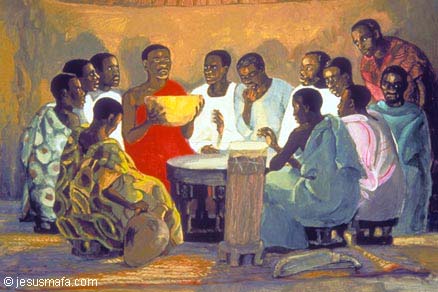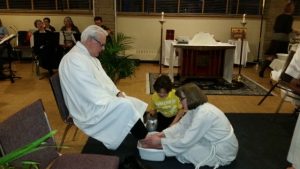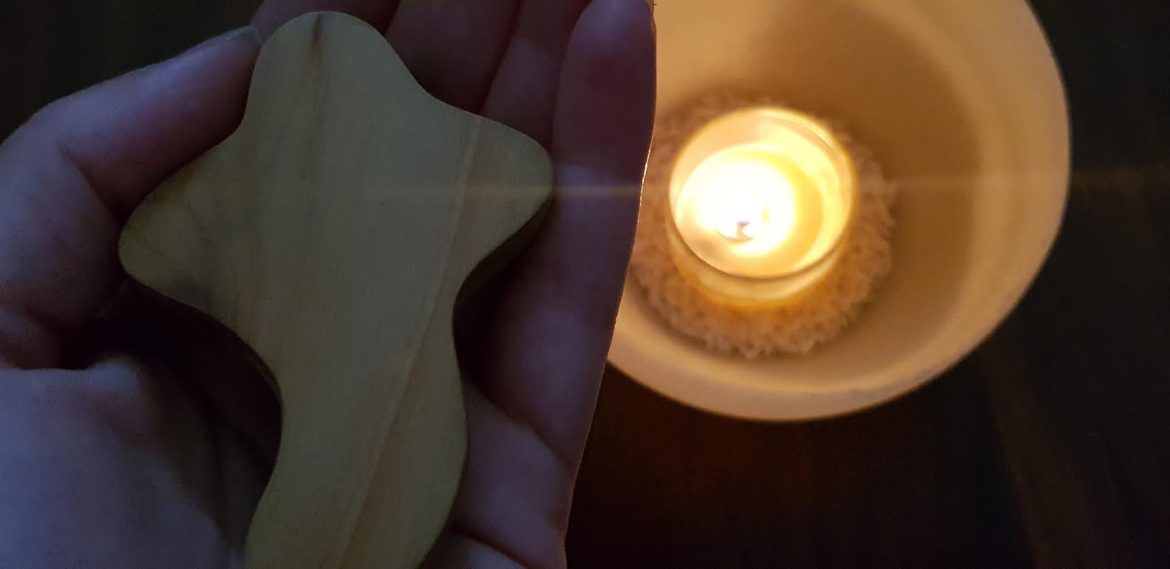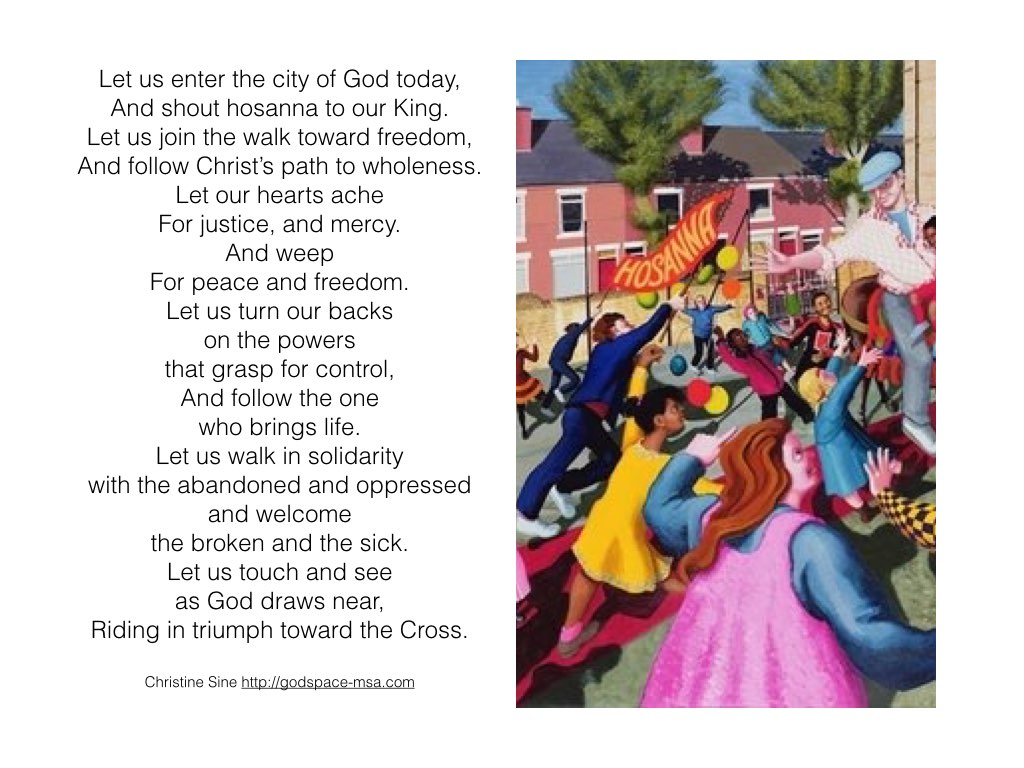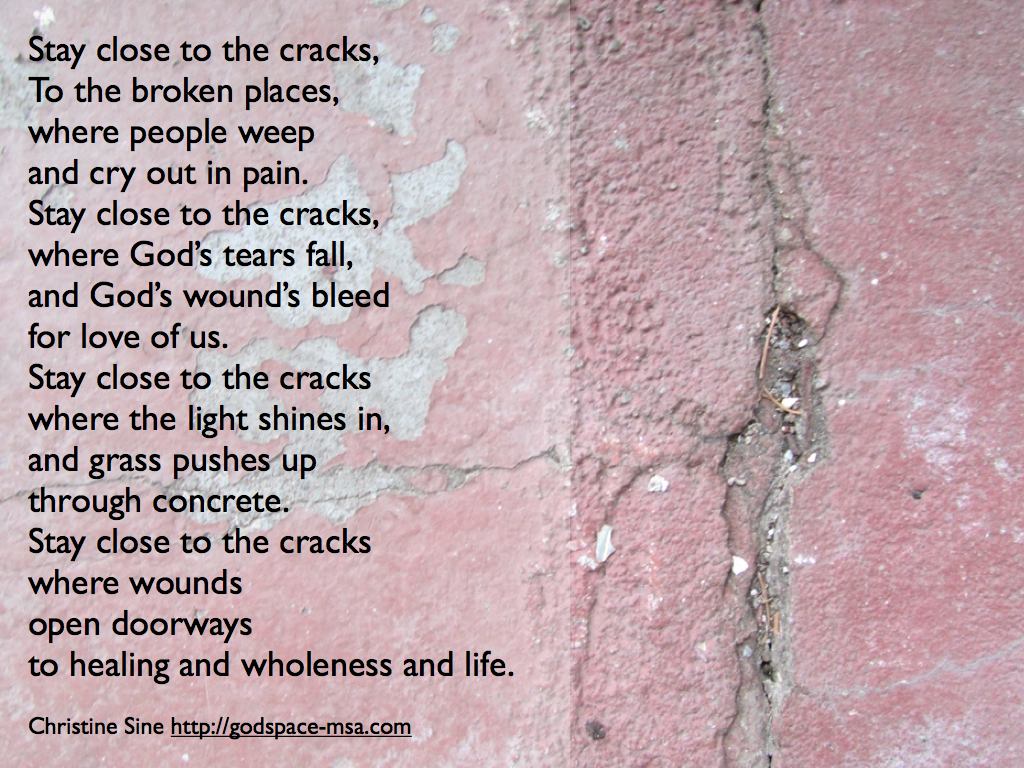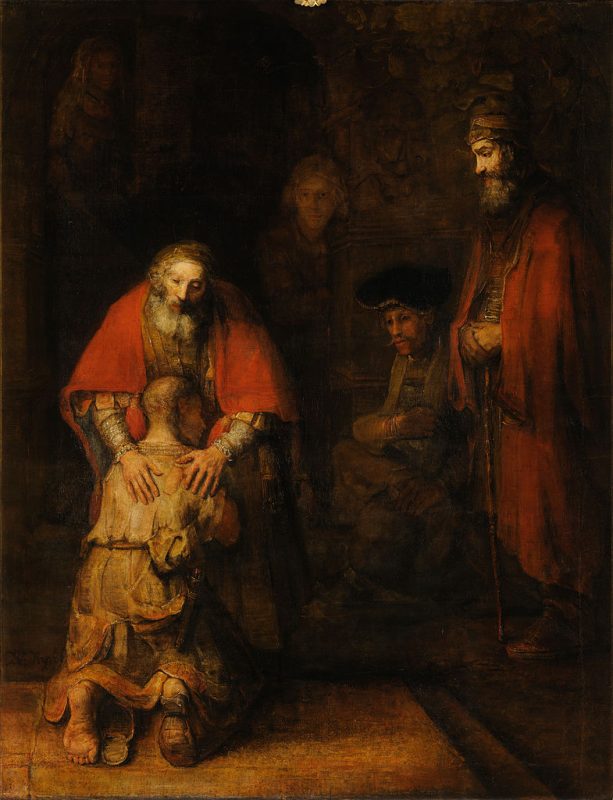“Do what the priest tells you!”
That was my Irish Catholic family’s policy for most of my childhood.
Things didn’t go well when I wanted to start reading the Bible for myself.
The priests warned me that the Bible was dangerous and that I shouldn’t read it on my own.
“Just listen to the Homily in church each Sunday, ” they assured me.
If there’s one thing American evangelicals get jumpy about, it’s any hint that someone is trying to the take the Bible away from them. These Catholic priests committed an “American evangelical mortal sin.”
After years of these attempts to control my Bible reading habits, I rebelled… by reading the Bible on my own. In the fallout of that decision, I left the Catholic Church for good and sought refuge in the Wild West of American evangelical Christianity.
During those years, I threw myself into service, mission, Scripture study, activism, and any other evangelical endeavor presented as authentic action for the truly committed. No matter how ineffective my work appeared, how much I struggled to become “pure” and “holy,” or how much I endeavored to be an influential culture warrior, I failed to ask if my foundational beliefs and practices were problematic.
Looking back now, I see that I made the mistake of trying to transform culture without first being transformed into someone worth imitating or able to offer something truly transformative.
Eventually, the fire of fighting spiritual battles faded for me, and the pursuit of God became deeply frustrating. I was left with only the hollow shell of my arguments and fears, and I lacked the substance of connection, let alone union, with God.
My evangelical anxiety peaked while in seminary.
At the end of my coursework I dropped my seminary diploma onto a dusty pile of theology books and realized that I had no idea how to pray. In retrospect, I realize now that I could exegete Scripture in the original languages, but I didn’t have words to pray. (Little did I know, I wouldn’t need many anyway.)
Then one day, a pastor I knew from one of my seminary classes invited me to his new prayer service. This was back when all the cutting-edge evangelicals were experimenting with liturgy, candles, prayer books, and in the extreme cases, art.
This pastor didn’t strike me as the type to jump on a trend. I think he genuinely wanted to figure out ways to make church meetings more meaningful and to provide a deeper connection with
God. Reluctantly, I agreed to show up.
Liturgy, chants, and candles were the last thing that I, as a former Catholic, wanted out of church. But I was desperate to prove to myself that I was still a Christian and to prove to myself that God is real.
If anything, attending the service felt like a huge step backward. Evangelicalism was supposed to be my savior, the thing that rescued me from the seemingly lifeless liturgy of my Catholic days.
The whole service was completely unlike anything I had experienced as either a Catholic or an evangelical.
We chanted about God’s love.
We spent time centering on the Jesus Prayer.
We meditated on Scripture using the slow reading practice known as lectio divina, which helped us pray the words of Scripture.
Throughout the service I kept worrying that I was doing it wrong and wondering why I wasn’t having an encounter with God. It didn’t seem to be working. Either I was hopelessly broken or God wasn’t real. I returned home defeated, and I plunged deeper into my spiritual despair.
Yet in the following days, months, even years, I found myself returning to those prayer practices. Perhaps the connection they provided with God was something other than the FLASH, BANG!!!! conversion experience I’d been taught to expect among evangelicals.
Little did I know, this pastor had sown the seeds for my spiritual liberation from the anxious,
hardworking evangelical tradition. The practices in this underwhelming service would transform my faith, help me learn how to pray again, and help me rediscover the love of God.
The answers to my spiritual formation questions and my desire to find the love of God could be found in the writings and practices of the Catholic contemplative teachers who had been preserving variations of these spiritual practices for generations since the days of the Desert Fathers and Mothers.
The walls I had built against Catholicism as a Bible major at a Christian university and as a seminary student came crashing down as I learned the freedom and quiet of contemplative prayer practices.
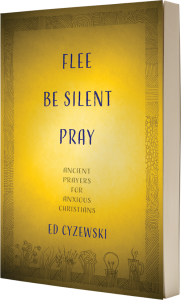 This post was adapted from Ed Cyzewski’s new book, Flee, Be Silent, Pray: Ancient Prayers for Anxious Christians.
This post was adapted from Ed Cyzewski’s new book, Flee, Be Silent, Pray: Ancient Prayers for Anxious Christians.
 Ed Cyzewski writes at www.edcyzewski.com and at the Patheos blog: This Kinda Contemplative Life. He is the author Flee, Be Silent, Pray, A Christian Survival Guide, and other books. Connect with him on Twitter @edcyzewski and Instagram @edcyzewski.
Ed Cyzewski writes at www.edcyzewski.com and at the Patheos blog: This Kinda Contemplative Life. He is the author Flee, Be Silent, Pray, A Christian Survival Guide, and other books. Connect with him on Twitter @edcyzewski and Instagram @edcyzewski.
Today’s post is an updated list of resources for Maundy Thursday, the day before Good Friday, which commemorates Jesus’ last Supper with the disciples and the institution of the Eucharist. Its name of “Maundy” comes from the Latin word mandatum, meaning “command.” This stems from Christ’s words in John 13:34, “A new commandment I give unto you. Love one another as I have loved you”. Many of us associate it with foot washing:
A rite performed by Christ upon his disciples to prepare them for the priesthood and the marriage banquet they will offer, and which is rooted in the Old Testament practice of foot-washing in preparation for the marital embrace (II Kings 11:8-11, Canticles 5:3) and in the ritual ablutions performed by the High Priest of the Old Covenant (contrast Leviticus 16:23-24 with John 13:3-5). The priest girds himself with a cloth and washes the feet of 12 men he’s chosen to represent the Apostles for the ceremony.
It is the oldest of the observances peculiar to Holy Week but seems to have attracted the least attention and I must confess creative suggestions were hard to come by. It has however become my favourite Holy Week observance.
For Celebrating At Home
- How to have a Maundy Thursday Liturgy at Home by MissioAlliance
- Maundy Thursday – 7 Churches at Home by Barefoot Abbey
- Stripping the Table by Building Faith
Free Maundy Thursday Resource
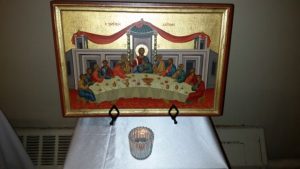 Our own church, Saint Andrews Episcopal Church in Seattle hosts an Agape feast and foot washing, one of the most beautiful celebrations I have been to. We re-enact the Last Supper with a wonderful lamb feast, beautiful litany that intertwines scripture and prayer, have the opportunity to wash each other’s feet and then process upstairs to the sanctuary to strip the altar for Good Friday. They have kindly made the liturgy for this celebration available for FREE DOWNLOAD from the Godspace resource centre.
Our own church, Saint Andrews Episcopal Church in Seattle hosts an Agape feast and foot washing, one of the most beautiful celebrations I have been to. We re-enact the Last Supper with a wonderful lamb feast, beautiful litany that intertwines scripture and prayer, have the opportunity to wash each other’s feet and then process upstairs to the sanctuary to strip the altar for Good Friday. They have kindly made the liturgy for this celebration available for FREE DOWNLOAD from the Godspace resource centre.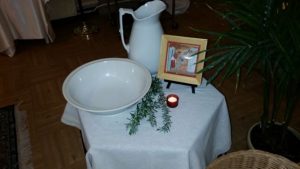
Footwashing
Foot washing has also taken on new significance for me in recent years as I reread two posts that have been contributed to my blog. Some of you might like to revisit these too.
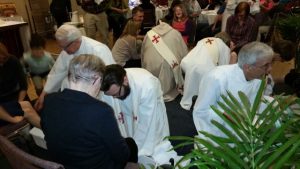
I also love this post Replacing Holy Week – Towards a Public + Local Liturgy by Brandon Rhodes. and suggest that you also watch this video Brandon put together that spells our some of what they have done since then the concretize their practices. Parish Practices: “Re-Placing Holy Week,” with Brandon Rhodes .
Parish Practices: “Re-Placing Holy Week,” with Brandon Rhodes from Parish Collective on Vimeo.
Consider a Tenebrae Service
- One form of service you might like to consider for either Maundy Thursday or Good Friday is a Tenebrae service. I like this resource from the Presbyterian church that helps explain this.
- And an “alternative service from UMC that has some creative ideas here.
- Another creative suggestion is what this Christian school in England did – not just washing feet but cleaning the neighbourhood.
- Or, check out the Maundy Thursday resources at re:Worship and those at Textweek.com
Other Observances For Maundy Thursday.
I have adapted other customs of Maundy Thursday here that you may like to consider for your own observances:
- Consider a Passover meal like the liturgy available for free above
- In Germany, Maundy Thursday is known as “Green Thursday” (Grundonnerstag), and the traditional foods are green vegetables and green salad, especially a spinach salad. Consider planning a vegetarian Last Supper banquet for your celebrations and highlight the environmental issues you are concerned about.
- Visit a local homeless camp or home for the elderly (make sure you get permission first) and do foot washing and pedicures for the inhabitants.
- This is the traditional night for an all night vigil of prayer and meditation. Give yours a new twist by holding an all night reading of Dante’s Inferno as St Philips in the Hills Episcopal Church has done for the last 5 years.
- This is a day to reach out and help someone in a special way: consider looking after a child so that the mother could have a free evening, undertaking some mending or darning, humble, unostentatious things like that.
- Visit 3 or 7 local churches or other places of worship after (or before) your own service.
- In Mark Pierson’s Lenten devotional for 2013, he comments: Jesus, a king who acted like a slave. Perhaps on Maundy Thursday you would like to consider a special way to reach out to those who are still in slavery.
- One symbol of Easter I grew up with that is not so common in the U.S. is hot cross buns which some think originated from a 12th-century English monk who placed the sign of the cross on the buns in honor of Good Friday. So if you want to have your hot crossed buns ready for Good Friday make them on Maundy Thursday, together with your family or community. Here is the recipe I use.
For those celebrating with kids I rather liked this Fill Your Seder Plate game.
So consider including this day in your Holy Week celebrations and if you do something creative let me know.
This is part of this series on Resources for Holy Week. Click here to view the others.
By Talitha Fraser —
I have been living in intentional community with refugees and asylum seekers since 2012. You know you’ll learn a lot from such an experience but what is more subtle is the unlearning… sometimes you need to deconstruct and reform your ideas of what hospitality is, what values are and how that can influence what you thought was black and white or ‘right’… like my ideal of recycling furniture secondhand next to the future you’ve dreamed of and risked so much for to having the first new furniture you’ve ever owned and chosen for yourself that comes from Kmart. The commitment isn’t to knowing one truest truth or having one answer but committing to a way of living lightly, into answers that might always change. This poem tries to capture some of how hard that work can be but affirm also how worthwhile it is to do. It is in our breaking we are Made. I wish that everyone could know that it’s those moments we feel most broken that most inform out Becoming.
Smooth whorls of wood
warm under my fingers.
It is in my making I am Made
but the first step is to become undone.
How then can I begrudge you
your moment of unravelling?
Natural and needed.
Evolution wasn’t a thing that happened once.
It’s happening now.
It’s happening.
Feel it.
Feel all of it. The fear, the wonder,
the breathless uncertainty.
Which way will it fall?
That’s a helpful trick… distancing.
The thing that’s falling is you
but free fall, is free form, is be born.
A labour and a life, hard won.
Not fun, but necessary, never done.
Take that step.
And the next.
And the one after that.
The steps, the text of your story, I want to read.
Bleed.
And walk.
by Christine Sine
With Palm Sunday just two weeks away I wanted to make sure that I got my resource list updated. I am reposting them this year so that it is easy for everyone to find them. Palm Sunday commemorates the entrance of Jesus into Jerusalem (Matthew 21:1–9), when palm branches were placed in his path, before his arrest on Holy Thursday and his crucifixion on Good Friday. It thus marks the beginning of Holy Week, the final week of Lent.
Here is just a sample of what happens during Holy Week:
- Palm Sunday, Jesus triumphantly enters Jerusalem
- Monday of Holy Week, Jesus clears out the temple with a whip
- Tuesday of Holy Week, Jesus is anointed with oil at Bethany and preaches on the Mount of Olives
- Spy Wednesday, Jesus is betrayed by Judas
- Holy Thursday, Jesus celebrates the Last Supper, prays in the Garden of Gethsemane, and is arrested
- Good Friday, Jesus is sentenced to death, scourged, beaten, crucified, and dies on the Cross
- Holy Saturday, Jesus is buried in the tomb and descends into hell
- Easter Sunday, Jesus rises from the dead
Holy Week Retreat
This is a great Holy Week retreat from Dynamic Catholic.
Palm Sunday
Palm Sunday commemorates the entrance of Jesus into Jerusalem (Matthew 21:1–9), when palm branches were placed in his path, before his arrest on Holy Thursday and his crucifixion on Good Friday. It thus marks the beginning of Holy Week, the final week of Lent.
Here is a simple introduction to Palm Sunday
For Palm Sunday at Home
- Palm Sunday at Home by Lilly Lewin – from 2020 applicable for 2022
- From Happy Event Day – Palm Sunday Resources, including printable coloring pages!
- Printable activities for kids and other resources from Sermons 4 Kids
- A Complete Guide to Celebrate Palm Sunday at Home by Aleteia
- 5 Ways to Celebrate by Crosswalk.com
- Powerline Productions offers some tips and ways to celebrate at home.
- Making Room for the Cross at Home by Down the Hobbit Hole blog
- Holy Week at Home by Benwellscottswood.com – from 2020, but still great resources to consider
- Interactive ideas for Holy Week at Home by the Trinity Mission
Taizé Style Services from St. Andrew’s Episcopal, Seattle
- A Contemplative Service in The Style of Taizé for Palm Sunday
- Palm Sunday Taizé Contemplative Service At St Andrews
Litanies for Palm Sunday
We are entering the most subversive week of Jesus life – it begins with shouts of Hosanna but ends with shouts of crucify him. Read more in my post Meditation Monday – The Subversive Walk of Holy Week.
In many churches, after a walk around the church waving palms, the litany actually focuses on the passion of Christ. This is because the following Sunday is Easter Sunday and though most churches hold services throughout Holy Week, some people will not come to church again until Easter Sunday.
- This Palm/Passion litany from the Evangelical Lutheran Church in America is an example of this.
- Fran Pratt has a beautiful Palm Sunday litany that you might like to look at too.
Use a Little Creativity
There are of course a huge number of resources available for this season but I particularly wanted to highlight some of the out of the box, creative ideas I have come across.
- I love these creative “out of the box” ideas from Steve Taylor (emergent kiwi) and his invitation to walk the streets and create outdoor spirit signs.
- Here is another very creative and interactive liturgy from Rowland Croucher at John Mark Ministries in Australia.
- Or you might like to download this Palm Sunday labyrinth. I think it would be a great focus for meditate on Palm Sunday.
- I have posted other creative suggestions on my Holy Week and Easter Pinterest board.
Here are some other suggestions you might like to get creative with.
- Palm Leaf Decorations: Use the blessed palm leaves to create decorations for your home or church, such as wreaths, crosses, or even palm leaf art. Here is one simple suggestion
- Weaving Palm Crosses: Learn to weave palm crosses, a traditional practice that symbolizes the cross of Jesus.
- DIY Palm Leaf Crafts: Engage in crafts like making paper palm leaves, origami palm leaves, or palm leaf art.
- Palm Sunday Coloring Pages: Use coloring pages to teach children about Palm Sunday and the events of Holy Week.
- Holy Week Wreath: Make a DIY holy week wreath using palm leaves and other materials.
- Cross Decorating Kit: Decorate a cross with palm leaves and other materials.
- Palm Leaf Art: Use palm leaves to create art projects, such as paintings, collages, or sculptures.
-
Palm Sunday Games:
Play Palm Sunday-themed games, such as a Bible word search or a “Hosanna” guessing game.
-
Pray for the World:
Pray for peace and justice in the world, as Jesus’ entry into Jerusalem was a time of both celebration and tension.
-
Study a Country:
Study about a country in the world, make a meal or order from a restaurant that makes food from that country, play a game from that country, pray for that country, or “adopt” a family from that country and invite them over to tell you about their country.
-
Decorate the grave of a loved one:Place branches, flowers, and palms at their resting place, and take time to remember their life.
Palms for Crosses and Fronds
- If you are concerned about whether or not the palms you are using are eco friendly check out this site. Ecopalms are concerned about social justice and environmental concerns. Well worth a look.
- Or, if you don’t know how to make palm crosses, check this out. It’s not hard once you know what to do.
Traditional resources for Palm Sunday.
- And another great “global arts collection” for Palm Sunday that helps us appreciate the ways different cultures view this event.
- As usual Textweek.com has a very comprehensive and excellent list of resources from all over the world to help prepare for this celebration.
- Anglican Prayer updated this list for Palm Sunday in 2014. Most of the links still work.
- Work of the People also always has good video clips available
- Some great prayers from Carol Penner
- Some great downloadable resources from the Mennonite Church Canada.
- And from our friends at re:Worship.
- A powerful film clip Scattered Palms from The Work of the People.
Getting Creative with our Palms
I posted these suggestions on what to do with our palms after the Sunday service. I like to hang onto mine to burn on Ash Wednesday the following year but there are lots of other creative things to do with them.
Minas Thomas has created a whole series of videos on palm weaving from a Coptic Christian perspective that are well worth viewing. He instructs us on everything from a simple cross to braiding of palm fronds and, a more complex Coptic cross and a donkey. Here is the link to the first video:
Reach Out To the Neighborhood for Palm Sunday
I encourage you think about ways to make the Palm Sunday procession a way to reach out to your neighbourhood rather than a way for your church to just have fun walking around singing songs. Maybe an invitation to a Sunday Easter lunch or another church event. Some friends of ours, Hilary and Trevor Horn, went around the neighborhood near their church giving succulents to all the people who have moved in over the last year. I think this would be a great activity for Palm Sunday.
My Favourite Palm Sunday Songs.
Benedictines of Mary have beautiful music for all seasons of the liturgical calendar including their Easter at Ephesus recording. Here is a glimpse of their beautiful music:
This post is part of a series on resources for Holy Week. Check out other posts in the series:
- Resources for Palm Sunday
- Resources for Maundy Thursday
- Resources for Good Friday
- Stations of the Cross
- Resources for Celebrating Holy Week With Kids:
- Resources for Easter Sunday
Please check out our complete list of Godspace resources for Lent through Holy Week
Today’s post is a repost from a few years ago, but as I looked at my garden with almost all the walls broken down this is what came to me. It is OK to break down walls, but it is easy for us then to run away from what the wall reveals, or we try to rebuild the walls so that they are even stronger, yet that is not what God asks of us.

Breaking down more walls
This post and the prayer that goes with it was inspired by Leonard Cohen’s powerful song “Anthem” which I link to at the bottom of the post. His prophetic voice and challenging words are very appropriate for our world today. He reminds us that there is indeed a crack in everything but this is not a reason for despair but rather for hope because this is indeed how the light gets in. I use this prayer at the beginning of the chapter on compassion in The Gift of Wonder.
In Eager to Love, Richard Rohr comments that St Francis of Assisi asked us to stay close to the cracks in the social fabric of our world. It is a thought worth reflecting on.
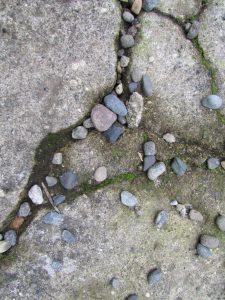
Everything in our lives and in our world has cracks, wounds and broken places that tell of pain and suffering. When we break down walls, cracks emerge. Sometimes we try to cover them over, attempting to seal them off from the light. But this only makes them fester and get worse.
Yet it is in the cracks, the broken places of our lives, where violence flares and pain cries out that healing also happens. When we acknowledge imperfections and the pain they cause, we take the first step towards wholeness. It is into the cracks that light can shine and water can seep. It is in the cracks in the concrete that seeds can lodge, germinate and take root. And as green shoots reach for the sky, the crack enlarges, the concrete crumbles and what was meant to live and breathe thrives once more.
What is your response?
Sit quietly in the presence of God, allowing the love of the holy and ever present One to wash over you. Read through the prayer above several times. What cracks in your world, what places of woundedness and vulnerability that give you ongoing pain come to mind? In what ways have you tried to cover these over, perhaps with a facade of laughter or with a semblance of respectability? Are there ways you respond, perhaps with fear, or anger or intolerance that show these are festering? Perhaps there are things you need to confess or seek forgiveness for. Offer these up to God in prayer.
Now think of the light that has shone into those cracks. Where have you seen glimmers of God’s wholeness? What has it begun to give life to? Are you aware of green shoots emerging towards the sun? How could you nurture their growth and make help them to thrive?
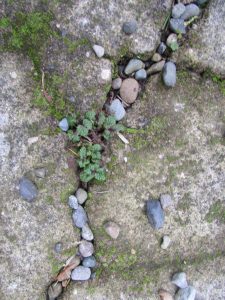
At our local mall recently I noticed that what was once a solid concrete slab of parking slots has now been transformed. The pavement (imagine wall) had been broken down. Deliberate “cracks” have been added between the rows of cars – small gardens that channel the water into the topsoil and down into the water table are thriving. The rain no longer creates a flood of water that overflows the drains and clogs the waterways.
Sometimes when we stay close to the cracks we realize that they need to be nurtured and strengthened to rebuild the fabric of our lives and our society. And as we nurture these it is not only the surface life that thrives but it is the deep wellsprings of the water table that flourishes too.
What is your response?
Read through the prayer above again. What slabs of pavement are you aware of in your life and society that need to be broken up with gardens? What walls have you broken down then reconstructed? Is there something the spirit of God is prompting you to do that could help accomplish this?
Now listen to the song below and allow the spirit of God to stir your imagination. Is there another response God is asking of you?
Photos by Christine Sine
‘No one is an island’ is a phrase that has been echoing round my mind for a while now. It echoes through all the talks, votes, rifts of Brexit; it echoes in the tragedies of shootings and hatred; it echoes through the rumblings of every division about land, about borders, about sovereignty and empire; it echoes in every felt change of ecosystems and climates. Although this phrase was written nearly four hundred years ago, I am hearing it with renewed resonance this Lent (not least with the help of this song from Tenth Avenue).
I had forgotten the context in which Anglican priest poet John Donne (who died 31st March 1631) wrote this phrase. It appears in his Devotions upon Emergent Occasions, a series of reflections written as Donne recovered from a near-fatal ‘sickness’. Donne writes about the first symptoms, the series of doctor’s consultations, the long hours of just lying there in pain, his medication, and his slow regaining strength. As someone who lives with a chronic (though by no means fatal) illness, I was fascinated and humbled by Donne’s gritty descriptions of the day to day realities of his condition and his wisdom in seeing every stage and aspect of an illness as a possible vehicle for God speaking to him in a particular, specific way. Donne reflects on his fear of death with a shocking honesty and as I re-read these Devotions I am constantly surprised by the unashamedly emotionally tumultuous tone of many of the meditations, expostulations and prayers. He reminds me to pray for my doctors, for their skill, for their doubts, fears and uncertainties. He reminds me to pray that every aspect of my illness will be an opportunity for surrender to God.
As Donne lay in his bed he could hear the bells of a church nearby. These bells formed the soundtrack of his illness, and became yet another vehicle for receiving God’s Grace. Hearing the ring of a single bell calling the congregation to a funeral forced Donne to reflect upon his own fear of death and his hopes of eternity. He knows that the bell could be sounding his own funeral, so in a series of imaginative prayerful acts (remarkably like the compassionate practice of Tonglen) he wonders about the life and death of the person who died; and about the lives, hopes and fears of all those who, like him, are listening to this same bell. Donne thanks God that the sound alone acts as a reminder to contemplate his Saviour in every aspect of his passing life and his approaching death.
As I write this, sitting in my own bed, I can hear the sound of sirens from the Ambulance station next door, and these have become my modern day equivalent of Donne’s church bells. Every siren is a prompt for me to pray, ‘for all those involved in that situation’: the patients, the families, the clinicians, the paramedics, the friends, the hospital porters… As I pray for each contact, each ripple, each healing, I ask for the Spirit’s spreading, so that pain may become peace, brokenness become wholeness, fear become love. In Donne’s words, ‘this bell calls us all’.
No-one is an island, however alone and abandoned I may sometimes have felt. Yet Thomas Merton, in his reflections upon Donne’s phrase ‘no man is an island’, saw that if I cannot recognise the value of my own loneliness, I cannot respect nor respond to the needs of others. Merton reminds me it is only through solitude that I can hear how God loves me, that I can understand who I am in God’s eyes, that I can accept the freedom I have been given to be God’s beloved: ‘and the more each individual develops and discovers the secret resources of his own incommunicable personality, the more he can contribute to the life and the weal of the whole.’ (‘The Inward Solitude’, No Man is an Island) Merton is insistent that ‘charity cannot be what it is supposed to be as long as I do not see that my life represents my own allotment in the life of a whole supernatural organism to which I belong’. (Prologue to No Man is an Island)
So even in my bed, even when I may not have any contact with a stranger (in person or on-line) for days and weeks on end, still, I remain connected to the whole of Creation. As a child of the Creator, even how I think of myself, in my moments of solitude and honesty before my God, and even how I treat myself, has ripples and repercussions: because I am connected.
If I become embittered, disgruntled, ungrateful, that will have an effect on how I treat every soul with whom I come into contact.
If I do not love myself, if I do not realise how connected I am within the loveweb of God’s cosmos, how can I show love to any other, even to those I do not see in the flesh?
If I refuse to love myself, how can I tell another of where to find that One called Love; how can I encourage them in turn to love the next creature they contact?
If I refuse to love myself, how can I build Kingdom one relationship at a time? As Merton writes,
Every other man is a piece of myself, for I am a part and a member of mankind… Solitude, humility, self-denial, action and contemplation, the sacraments, the monastic life, the family, war and peace – none of these make sense except in relation to the central reality which is God’s love living and acting in those who He has incorporated in His Christ. Nothing at all makes sense, unless we admit, with John Donne, that: “No man is an island, entire of itself; every man is a piece of the continent, a part of the main.” (Prologue to No Man is an Island)
by Lilly Lewin
This week’s lectionary gospel passage is Luke 15: 11-32 “The Prodigal Son,” or “the Forgiving Father.” This is a meditation I wrote originally for Rembrandt’s painting “Return of the Prodigal” but I suggest you take some time to reflect on some other paintings of this famous parable. The one below is by artist Jesus Mafa from Cameroon. It’s a beautiful example of the return. I love the woman with her arms raised in celebration. Perhaps the mom of the prodigal? What was she like? 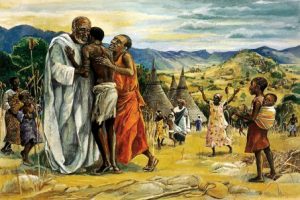
google search for other images to use in your reflection here and here.
The Return of the Prodigal Son
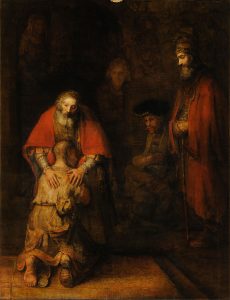 REMBRANDT Harmenszoon van Rijn c. 1669 The Hermitage, St. Petersburg
REMBRANDT Harmenszoon van Rijn c. 1669 The Hermitage, St. Petersburg
Consider the Painting. Look at it closely. Spend some time. Allow God to speak to you. Look, Consider and Listen…
READ THE TEXT …put your imagination to work…picture the story in your mind.
Smell the pigs and feel the wretchedness of the younger son. Use this painting from the National Gallery in Washington, DC to help you with this.
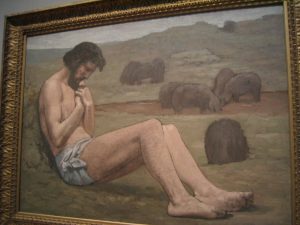
- Pierre Puvis de Chavannes
- French, 1824 – 1898
- The Prodigal Son
- probably c. 1879
Look at the encounter between father and son…both the encounter with the returning son and the son who stayed at home. What do you see?
When you read the story Jesus told…where do you see yourself?
Do you feel like the younger son or the older son?
Or maybe you feel like the dad in the story?
Or one of the servants surprised by the son’s return?
Take some time and consider this …
What do you notice about the younger son?
What do you notice about the father?
How about the older son and the servants?
Look at the painting.
What are you feeling like lately? Have you been running away?
Do you need to be welcomed back home? Have you squandered your inheritance or abandoned things you once loved?
Are you feeling like the younger son?
How does it feel to have a Father, God, who welcomes you back home even when you’ve thrown everything away?
How does it feel to have God embrace you? Picture God the father hugging you close.
Do you need a new robe today?
Do you need to be thrown a party and to be celebrated and honored?
What would that be like in your life right now?
Have you been feeling like the oldest son lately?
Working hard and doing all the right things but being frustrated?
What if you’ve been faithful and steady? What if you’ve stayed true to what you’re supposed to be and do? How does that feel today?
We all need a reminder of what we have, the blessing of Father God, the honor of being the “oldest” child. We all need to be reminded that God is just waiting for us to receive this honor, love, and embrace!
Is there anyone in your life that you are envious of …any prodigals that you’ve resented? Talk to God about this.
God is waiting to bestow grace, mercy and God’s forgiveness on YOU!
God longs to embrace you and throw you a party even if you haven’t gotten lost.
Take some time to day to open your heart to receive this gift. Use the art to help you receive it in the days ahead.
©lillylewin freerangeworship.com
As an Amazon Associate, I receive a small amount for purchases made through appropriate links.
Thank you for supporting Godspace in this way.
When referencing or quoting Godspace Light, please be sure to include the Author (Christine Sine unless otherwise noted), the Title of the article or resource, the Source link where appropriate, and ©Godspacelight.com. Thank you!


